No Lectures, no exams, and no graded homework - but you will learn much more...
Students will be assigned reading weekly. They will purchase the book, at a greatly reduced price ($60.00 for the electronic version), at a special website that Wiley is setting up for us. Once they purchase the book they will get access to a classroom at the website: nb.mit.edu
Students will highlight sections of the text and write about it on this website. The annotations will be visible to the entire class and the instructors. Students will be told that they can rephrase difficult to understand concepts, fill in confusing steps in derivations, detect errors in the book, show better ways to illustrate the ideas than the examples in the book, ask great questions, and answer (correctly) other people's questions. Students will be graded based on the quantity and quality of their annotations. They will be told that 1 annotation per week is too little and more than 20 annotations are too much. 7 really excellent annotations or correct answers to another student's good questions would give them full credit for the week as long as they are completed in time and cover all of the material.
Annotating in NB
NOTE: This is subject to change before the course begins. The rubric is in the process of being refined and may not be exactly as indicated below by September.
As stated in the syllabus, 25% of the course grade is based on your annotations of the text. Your annotations, like most of the other course components, are evaluated on (genuine) effort. What matters is that you convince us that you have engaged in thorough and thoughtful reading and insightful interpretation of the text.
Why annotate?
Annotating the text helps you and us. First, you get practice reading a technical textbook. Once you graduate, books will be your primary vehicle for learning and, trust us, learning does not stop when you graduate. If you can learn from books, you have mastered an important lifelong skill. Second, by reading with attention and with an inquiring mind, you take ownership of your learning. That skill too will be useful for your whole life (in fact, you may want to start reading ahead in some of your other science classes to get more out of those classes; you’ll have to read those books at some point anyway!).
Third, by annotating the text, you are reversing the roles of student and teacher: for a change you are the one determining what’s wrong or confusing. In a traditional class, it’s always the teacher telling you what is wrong or confusing about your work. When you annotate the text because you are confused, you have identified a problem in the text: you are right and the author is wrong! By communicating that confusion to others, you create an opportunity to address the confusion and learn. If many people in the class express confusion about a particular topic, we will know that we need to address that confusion in class or online.
How (much) should I annotate? (what we expect)
As we have no lectures, the reading is your initial —and in some sense primary —exposure to the content of this class. It is therefore essential that you study each chapter with an inquisitive mind. Your annotations can either be queries, comments, or answers/reactions to queries or comments posted by others.
When we look at your annotations we want them to reflect the effort you put in your study of the text. It is unlikely that that effort will be reflected by just one or two annotations per chapter, unless your annotations are unusually thoughtful and stimulate a deep discussion. On the other extreme, 30 per chapter is probably too many, unless they are very superficial comments or questions. Somewhere in between these two extremes is about right. Last year the mean number of annotations per student was about 10/chapter.
When do I get feedback on my annotations?
The syllabus lists the recommended reading schedule; it is your task to stay on top of this schedule and plan your time accordingly. Each assignment has a deadline, which is 3:30 pm on the day of class. It probably pays not to wait until the last minute, so as to give others in the class an opportunity to respond and thus maximize the benefit of your annotations.
About 4-7 days after the deadline of the last chapter in each week, we will provide an overall assessment of your annotations in that week using the evaluation rubric on the next page.
We will continuously monitor the annotations to make sure burning questions are addressed, but we will always first allow others in the class an opportunity to answer or resolve queries before jumping in. After the class has the opportunity to participate, we may decide to contribute to the discussion, if necessary.
How will my annotations evaluated?
Your annotations will be evaluated on the basis of both quality, quantity, and timeliness. Your goal is to demonstrate significant timely and thoughtful reading of the text.
Below is the grading rubric and example sheet.
Please click on the image to get a pdf of each document.


MSE 220 Fall 2014